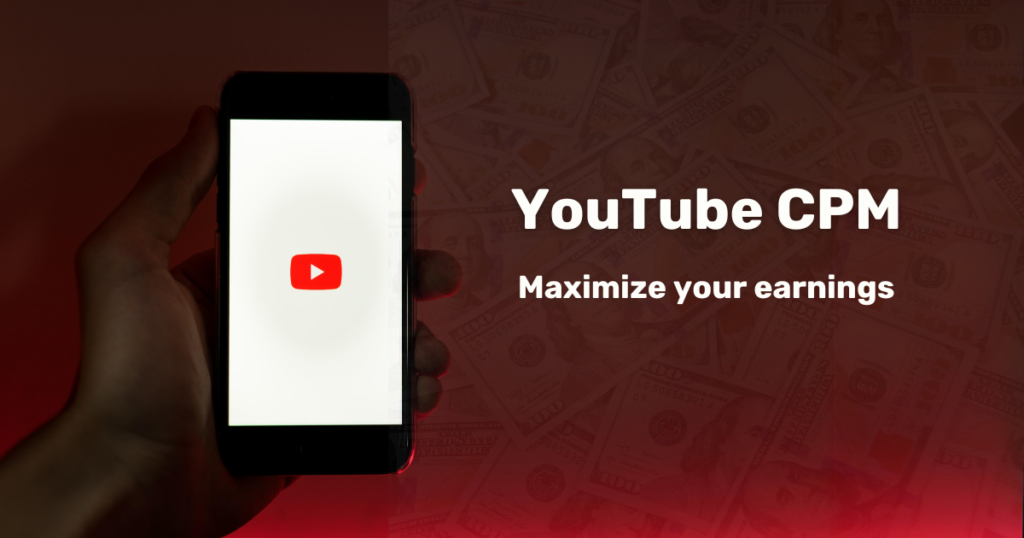YouTube is one of the most lucrative platforms for creators to earn money from. And the reason for this is its revenue sharing ad system. At the heart of YouTube monetization is CPM, or Cost Per Mille. For any YouTuber serious about making an income by joining the YouTube Partner Program (YPP), understanding what CPM is, and how it works, is the key to earning more.
What is YouTube CPM
CPM, or “Cost Per Mille” (“mille” is Latin for “thousand”), means the cost per 1,000 views. It represents the amount of money advertisers are willing to pay to have their ads displayed in your videos, calculated per 1,000 impressions. The higher the CPM the more revenue you’ll earn per 1,000 views.
A high CPM indicates that advertisers value your audience highly. This value is determined by key factors, including the niche of your content, the demographics of your audience, and the overall engagement with your videos. For example, content aimed at older demographics or in high-value niches like finance or technology often attracts higher CPMs.
Average YouTube CPM Rates
Depending on who you ask, you may have heard of CPM rates spanning anywhere from $0.30 to $100 dollars or more. The truth is that CPM rates are not static and fluctuate wildly based on market trends, changes in YouTube’s algorithms, and several other factors that we’ll get into soon.
However, to help create a sense of what one might expect to earn, let’s pretend we have a video that’s received 10,000 views and has a CPM of $2.00. To calculate how much money you’d make, you’ll need to use the following formula: ($2.00 / 1,000) * 10,000 – which comes out to $20.
Of course this is before factoring in YouTube’s 45% share of the revenue. After YouTube’s cut, the creator would take home $11.00.
Based on a video with 10,000 views, here’s how much you’d earn with CPMs ranging from $1 to $10.
| CPM | Total earnings | Youtube’s split | Creator’s split |
|---|---|---|---|
| $1.00 | $10.00 | $4.50 | $5.50 |
| $2.00 | $20.00 | $9.00 | $11.00 |
| $3.00 | $30.00 | $13.50 | $16.50 |
| $4.00 | $40.00 | $18.00 | $22.00 |
| $5.00 | $50.00 | $22.50 | $27.50 |
| $6.00 | $60.00 | $27.00 | $33.00 |
| $7.00 | $70.00 | $31.50 | $38.50 |
| $8.00 | $80.00 | $36.00 | $44.00 |
| $9.00 | $90.00 | $40.50 | $49.50 |
| $10.00 | $100.00 | $45.00 | $55.00 |
6 Factors that Influence YouTube CPM
Advertisers use a combination of factors to decide how much they’re willing to pay for ad placements. Here are the six key factors advertisers are looking for when it comes to determining what they’ll pay to have their brand in front of your audience:
- Audience demographics
- Niche
- Content quality
- Ad inventory and competition
- Viewer engagement
- Ad type and format
Audience Demographics
Advertisers target specific groups based on age, gender, location, interests, and more. If your audience aligns well with the advertiser’s target demographic, the CPM for your videos could be higher. For instance, content that appeals to an audience with high purchasing power (like adults aged 25-34 in cities with higher costs of living) might attract higher-paying advertisers.
Niche
Videos in niches like technology, finance, business, and health tend to attract the highest CPMs. These niches are considered high-value for several reasons, due to advertiser demand, audience purchasing power, and the potential for driving meaningful engagement or conversions.
Here are some examples of high-value niches:
- Technology and gadgets. This niche attracts tech enthusiasts and consumers looking to make informed purchasing decisions, offering advertisers a valuable audience ready to spend on the latest gadgets.
- Finance and investing. Content related to personal finance draws an audience interested in financial growth, attracting finance-related services and high-end advertisers.
- Business and entrepreneurship. Videos targeting professionals, entrepreneurs, or small business owners often see higher CPMs due to the interest from B2B services, software tools, and professional development programs.
- Health and wellness. This broad niche, covering everything from fitness to mental health, appeals to a wide range of health and wellness advertisers, including fitness apps, nutritional supplements, and health services.
- Luxury goods and services. Content focusing on luxury lifestyles, high-end travel, and premium products appeals to advertisers in the luxury market segment, who are typically willing to invest significantly in their ad spend.
Content Quality
The quality of your content can also significantly impact your CPM. Channels with an engaged, informed audience often draw higher CPMs by advertisers seeking to reach a reliable demographic.
High-quality content in this context refers to several aspects:
- Production quality. High-definition videos with clear sound and a visually appealing format are more likely to attract and retain viewers, thereby appealing to advertisers.
- Content depth and expertise. Another hallmark of quality content is when the topic is well-researched, informative, and expertly presented. In niches like technology, finance, business, and health in particular, accuracy is paramount to building trust not only with your audience, but with advertisers as well.
- Consistency. Advertisers value channels that consistently deliver content that resonates and engages their target audience.
- Viewer engagement and responsiveness. High-quality content also means creating videos that foster viewer interaction. This includes encouraging viewers to comment, like, and share, and also responding to comments and feedback. Engaged viewers are a sign that your content connects with your audience, thereby increasing its value to advertisers.
- Originality and creativity. Unique and compelling content that stands out in a crowded niche can also define quality. Videos that offer new perspectives, innovative ideas, or creative ways of presenting topics can attract more viewers and, by extension, more advertisers.
By focusing on these aspects of quality, your videos are more likely to draw higher CPMs. Advertisers often seek out content that not only reaches their target audience, but engages them with high-quality, authoritative information.
Ad Inventory and Competition
A content creator’s CPM is partly determined by how many ad slots are available on their videos, and how much advertisers are willing to pay for those slots. High demand from advertisers, especially during peak times, lead to higher CPMs – while low demand leads to lower CPMs.
Here’s a closer look at these dynamics:
- Ad inventory. Similar to ad spots in traditional media like TV or magazines, YouTube’s ad inventory is finite. Each video can host only a certain number of ads, and this limitation creates a valuable commodity for advertisers.
- Competition between advertisers. Advertiser competition for these limited ad slots plays a significant role in determining CPM rates. When multiple advertisers target the same audience, a bidding war ensues. As a result, bidders will pay a premium on CPM in order to secure ad slots on popular or highly relevant videos over their competitors.
- Peak times and seasonality. The intensity of this competition can vary throughout the year, particularly during peak times like holiday seasons, major global events, or even specific trends relevant to certain industries. During these periods, advertisers are more aggressive in their bidding, leading to even higher CPM rates.
Related: How to Get Sponsorships for Your YouTube Channel
Viewer Engagement
Advertisers favor content that keeps viewers engaged. Engagement metrics like watch time, likes, comments, and shares, suggests to advertisers that viewers are not only watching the content, but are also interacting with it in meaningful ways. This level of engagement can lead to better ad performance, as engaged viewers are more likely to notice and respond positively to ads.
Viewer engagement is also closely tied to viewer retention, which is another critical factor in determining CPM. Videos that keep viewers watching for longer durations are more likely to receive higher CPM rates.
Ad Type and Format
YouTube offers multiple ad formats, each with its own impact on viewer experience and advertiser value. Understanding these ad types and how they relate to CPM can help YouTuber’s strategize their content and monetization approach more effectively.
Here are the six YouTube ad types:
- Skippable in-stream ads. These are the most common ad types on YouTube, where viewers have the option to skip the ad after 5 seconds. While they are user-friendly, the CPM for these ads can vary. The CPM is often influenced by the viewer’s decision to watch the ad fully or skip it, impacting the overall ad revenue.
- Non-skippable in-stream ads. These ads must be watched entirely before the viewer is able to watch the video. Because they guarantee full viewer exposure to the advertiser’s message, they typically command higher CPM rates.
- In-feed video ads. In-feed video ads appear in places where viewers discover content, such as on the mobile homepage, within search results, or under the “Up next” videos. Earnings from in-feed video ads differ from other ad formats because in-feed video ads rely on user engagement (clicks) rather than just views or impressions.
- Bumper ads. At 6 seconds long and non-skippable, bumper ads are for advertisers looking to build brand awareness. Due to their short nature, they are less likely to disrupt viewer experience significantly and can yield reasonable CPM rates.
- Outstream ads. Outstream ads are mobile-only ads and don’t run on YouTube. Instead appearing on partner sites and apps which means that creators don’t share in any of the revenue from advertisers who run them.
- Masthead ads. Masthead ads are a premium advertising format displayed at the top of YouTube’s homepage, often used to promote movie releases or product launches. Unfortunately, this is another ad format where there’s no revenue share with creators.
Strategies to Increase Your YouTube CPM
So you’ve finally been accepted into the YouTube Partner Program (YPP), enabling you to monetize your videos. You turn it on, excited that you’ll finally get paid for your efforts, only to realize that you’re going to need tens of thousands of views just to make a couple of bucks. This moment can feel demotivating due to the effort and time you invested in producing content just to get here.
Fortunately, there are actions you can take to increase the CPM on your videos. A higher CPM means more revenue to invest back into your channel, and offers a more stable and rewarding experience as a YouTuber.
Here are four effective strategies to help increase your YouTube CPM:
- Pursue a high-value audience
- Create high-intent content
- Leverage YouTube Analytics
- Keep your content compliant
Pursue a High-value Audience
Attracting an audience that drives higher advertiser spending requires an understanding of what exactly makes an audience “high-value.” Factors such as niche, geography, and level of engagement all come into play when it comes to determining value.
Below are some steps you can take to find an audience that advertisers will pay top dollar for:
- Target a niche with high CPMs. As mentioned previously, niches like finance, technology, business, health, and lifestyle often see higher CPMs. Creating content in these areas can attract more lucrative advertising.
- Make content for high-CPM countries. Viewers from countries with higher ad spending, such as the United States, Canada, and the United Kingdom, yield higher CPMs when compared to other geos. Tailoring your content to appeal to audiences in these regions, will result in higher-paying ads.
- Go after high value keywords. Utilize YouTube SEO to target the keywords high-value audiences are most likely to be searching. Actions such as optimizing your video titles, descriptions, and tags with relevant keywords can help your videos rank higher in YouTube search results.
Create High Intent Content
High-intent content addresses viewers at a critical decision-making point. This could be a tutorial, a product review, a comparison video, or detailed guides on specific topics. For example, a video titled “Best Graphic Design Software for Beginners” targets viewers who are not just casually browsing, but are in the market to purchase graphic design software.
This type of content garners higher CPMs for the following reasons:
They’re reaching a motivated audience. High-intent content captures viewers who are gathering information to make a decision or are ready to buy. By placing their ads on these types of videos, advertisers are more likely to convert ad impressions into paying customers.
The ad placements are highly relevant. Advertisers are willing to pay a premium to place their ads on content where they know purchase intent is high, and the topic is relevant to their customers. For instance, ads for graphic design laptops on a video about the best graphic design software are more likely to result in conversions.
Leverage YouTube Analytics
One of the most powerful tools for increasing CPM is YouTube Analytics. By analyzing and applying insights from this data, creators can make informed decisions to optimize their content strategy and boost their CPMs.
To make the most of YouTube Analytics, here are some key areas to explore:
- Age, gender, and location. Content that resonates with audiences in high-CPM regions will earn you higher-paying ads.
- Device and platform. Knowing whether your audience watches more on mobile or desktop can help tailor your content format and ad settings.
- Watch time and retention rates. Poor watch time and low retention rates means that people aren’t sticking around long enough to engage with your content or the ads placed on it.
- Popular videos. Analyzing your top-performing content will give you insights into topics, styles, or formats that you might want to double down on.
- Likes, comments, and shares. High engagement rates are a positive signal to advertisers. Engaging content tends to attract more and higher-quality ads.
- CTR on ads. Understanding how viewers interact with ads on your videos can give you insights into what types of ads work best with your content.
- Trends and patterns. Look for patterns in when your videos gain more views and engagement. Aligning your posting schedule with these trends can increase visibility and CPMs.
- Test different content types. Experiment with different video types, lengths, and formats to see what yields the best CPM performance.
Keep your content compliant
Adhering to YouTube’s monetization policies and avoiding content that could lead to lower CPM or demonetization are critical factors in maintaining, and potentially increasing, your earnings. Many advertisers use filters to avoid placing ads on content that doesn’t align with their brand values or YouTube’s guidelines.
Content that is considered controversial, overly explicit, or otherwise non-compliant with YouTube’s guidelines can be less appealing to advertisers. In fact, many advertisers use filters to avoid placing ads on content that doesn’t align with their brand values.
Videos that violate YouTube’s policies may also face demonetization, meaning they won’t earn any ad revenue at all. Even temporary demonetization can impact overall earnings and disrupt audience growth, as it can affect how often your content is recommended to viewers.
Frequently Asked Questions (FAQs)
What is RPM?
RPM stands for Revenue Per Mille, which measures the average revenue a creator earns for every thousand views on their channel, including ads, channel memberships, Super Chat, and YouTube Premium revenue. RPM is calculated by dividing your total revenue by your total views in a given period, then multiplying by 1,000. Unlike CPM, RPM provides a more comprehensive understanding of a creator’s overall earnings relative to their views.
What’s the difference between CPM and RPM?
The key difference between CPM and RPM lies in what they measure and represent. CPM is focused on the advertiser’s perspective, indicating the cost of placing ads on YouTube. It doesn’t reflect the actual amount a creator earns. RPM, on the other hand, is centered on the creator’s perspective, representing the actual revenue earned per thousand views after YouTube’s cut.
RPM is generally lower than CPM because it considers the total number of video views (not just monetized views) and includes YouTube’s revenue share deduction.
Do all views count towards CPM?
No, only monetized views count towards CPM. Monetized views are those where viewers either see or interact with an ad.




